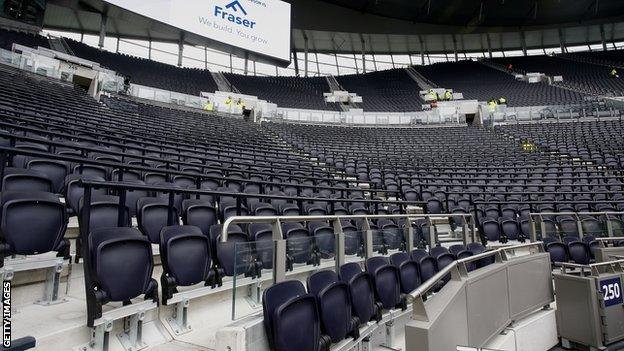Safe standing: Seating areas with barriers have 'positive impact' on fans' safety, says report
- Published

Tottenham's new stadium has seating areas that have been "future-proofed for safe standing"
Seating areas at football grounds which incorporate barriers have a "positive impact on spectator safety", a government report has found.
The interim report from the Sports Grounds Safety Authority (SGSA) found such seating areas "mitigate the risk of crowd collapse".
It comes after the government stated it "will work with fans and clubs towards introducing safe standing".
Sports Minister Nigel Adams said he "welcomed" the SGSA's findings.
"Over a million people watch live football at a ground every week, and having spoken to fans across the country, I know that safe standing is an issue many feel passionately about," he said.
"As we made clear in our election manifesto, we will work with fans and clubs towards introducing safe standing at football grounds.
"However, it is imperative that football remains as safe as it has become over the past 25 years. Robust evidence that this change will provide equivalent or improved safety for supporters, will be absolutely paramount to this process.
"There is more work that needs to be done. The SGSA is continuing to gather evidence over the course of this season, and I have asked them to work with the relevant authorities to consider next steps as we work with clubs and fans to introduce safe standing."
In October, the SGSA was asked to look into how safe standing is implemented at British and European clubs, and how persistent standing is managed elsewhere, after a previous government-commissioned report said more evidence was required before safe standing could be adopted.
However, it is not being trialled in England's top two leagues this season, despite the previous report suggesting controlled tests would have value.
The SGSA's report also found:
Clubs have developed management strategies appropriate to their stadiums which enable them to deal with persistent standing.
Wheelchair platforms can be incorporated into seating areas with barriers.
There has been "very little conflict" between fans, or between fans and stewards, as a result of standing in areas with barriers.
SGSA chief executive Martyn Henderson said: "Our research is providing new insights into the positive impact that installing seats with barriers can have on crowd safety.
"The research is ongoing and we will publish the final report at the end of season. In the meantime, we will work closely with the Government on the implementation of its manifesto commitment to introduce safe standing."
What's the background?
Standing in English football's top two tiers is illegal after recommendations made following the 1989 Hillsborough disaster, which resulted in the deaths of 96 Liverpool fans.
Standing is currently allowed in League One and League Two and several top-flight clubs are exploring the possibility.
The Football Association, Premier League and EFL have all said they would support clubs choosing to implement safe standing if local authorities allow it.
Tottenham's new stadium has "safe seating" which has been "future-proofed" for the potential introduction of standing, while Wolves installed rail seating at their Molineux ground in the summer.
Manchester United said in September they were looking into the feasibility of rail seating at Old Trafford, while Everton have plans for safe-standing areas when their new stadium is built.
Scotland is not bound by the law which banned standing areas in England and Celtic became the first Premiership side to introduce a rail seating area, for the 2016-17 season, after being granted permission by Glasgow City Council.